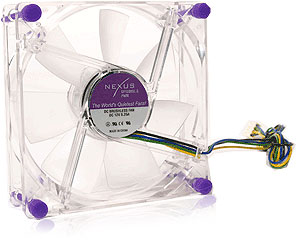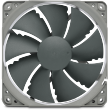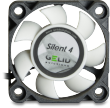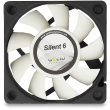92mm PWM Series Real Silent Case Fan Discontinued | |
| More variations available Show | |
Nexus 92mm PWM Series Real Silent Case Fan

After leading the market for many years with their BASIC series silent fans Nexus thought it was time to release a PWM version of their fans. All Nexus’ expertise and experience has been put in these PWM fan models. They have strived to set them up with the best possible characteristics. Great performance and extreme low dB(A) ratings are guaranteed.
The Nexus 92mm PWM Series case fan has an extra big fan speed range. This allows the fan to be ultra quiet at low speed and provide massive air flow at full speed in case thing get too hot.
Features
- Award winning cooling fan
- Supplied with four silicone fan mounts
- Very quiet, 15.8 db(A) @ 700 RPM
- Massive RPM range
- Three year warranty
| Specifications | 92mm PWM |
|---|---|
| Model number | DF1209SL-3PWM |
| Dimensions | 92x92x25mm |
| Versions | Clear chassis and foggy rotor/blades |
| Fan mounts | 4 pieces purple ultra-soft silicone fan mounts |
| Fan speed | 700 ~ 2500 RPM (±10%) |
| Noise level | From 15.8 dB(A) * |
| Airflow | Up to 43.5 CFM |
| Static Pressure | 3.15mm H2O |
| Rating voltage | DC 12V |
| Voltage range | DC 7V ~ DC 13.8V |
| Starting voltage | 7V |
| Label current | 0.15A (Max.) |
| Working current | 0.17A ±15% |
| Power consumption | 2.04W ±15% |
| Operating temperature | -10°C ~ 70°C |
| Warranty | 24 months |
| EAN barcode | 8717371699208 |
- *Measured in an ISO certified chamber with 15 dB(A) background noise
| Specifications | 92mm PWM |
|---|---|
| Model number | DF1209SL-3PWM |
| Dimensions | 92x92x25mm |
| Versions | Clear chassis and foggy rotor/blades |
| Fan mounts | 4 pieces purple ultra-soft silicone fan mounts |
| Fan speed | 700 ~ 2500 RPM (±10%) |
| Noise level | From 15.8 dB(A) * |
| Airflow | Up to 43.5 CFM |
| Static Pressure | 3.15mm H2O |
| Rating voltage | DC 12V |
| Voltage range | DC 7V ~ DC 13.8V |
| Starting voltage | 7V |
| Label current | 0.15A (Max.) |
| Working current | 0.17A ±15% |
| Power consumption | 2.04W ±15% |
| Operating temperature | -10°C ~ 70°C |
| Warranty | 24 months |
| EAN barcode | 8717371699208 |
- *Measured in an ISO certified chamber with 15 dB(A) background noise
Customer Reviews
Good fan, if you can get it set up right
This was the second thing I bought in my quest to silence my PC - the PSU in the case I repurposed turned out to be too weedy for my components, so that had already been swapped out for a bequiet model.
The next noisiest component in my case was the 92mm exhaust fan. My motherboard is a mid-range mATX 1155 board from Gigabyte, which besides the CPU fan header has just one “sys fan” header - but I only need one fan in there besides the CPU cooler, so to me it stood to reason a PWM fan as the headers on my board are 4-pin.
So I bought and installed this and, to be honest I was disappointed. Because it does have a fairly high top RPM it’s pretty noisy at the high end, and because the fan control settings on my motherboard bios are fairly limited, there was no real way to set a custom curve that kept the noise down - I had to run SpeedFan on startup in Windows to get it to spin down, which isn’t very elegant.
It’s not really the fault of the fan or my board - just not the best combination, and something worth highlighting. Also if you have a fan controller, or your board supports voltage control of the fans (turns out mine does) it’s worth avoiding PWM fans as they do seem to emit a kind of ticking noise when you spin them down - e.g. the Intel in-box CPU coolers, though they are fairly quiet overall, are pretty bad for this. This fan wasn’t bad in that area but I think voltage control is definitely smoother.
I’ve since purchased a Noctua NH-U9B, which comes with two NF-B9 fans - I only needed one on the CPU cooler, so the spare fan has replaced this one as the exhaust, and I can barely hear it. No in-line voltage adapter, just straight into my board with voltage regulation enabled and ‘silent’ set as the fan profile.
So to conclude, I guess, this is a good fan but you need to either have a PWM controller, run something like SpeedFan, or have a motherboard with some very fine PWM controls. Not a bad fan, but you can avoid that hassle by picking something with a slower top RPM.
Not sure about this one...
Sure it’s quiet. But it’s only running at 900RPM.
I got this to install into my case to add extra airflow primarily to stop dust from being able to gather at the bottom of the case.
Unfortunately I didn’t realise that my last free connector was only a 3 pin and therefore not a PWM fan. Thus this fan (and any other) run at max speed and are extremely loud. At full speed this fan sounds very loud but not half as loud as the other generic brand fans I have.
Anyway so instead I replaced my old 120mm generic brand 3 pin fan (that was plugged into a 4-pin exhaust port) that ran constantly at 800rpm with this one which runs at about 900rpm on PWM.
The result? It’s absolutely silent. BUT!!!!
there is no airflow… which is why I am back on this site looking for an alternative. I am going to change this one from being my exhaust fan to be my CPU fan. You may think, why? because the airflow is pretty bad. The reason for that is the airflow at max speed, and high speed is extremely good and my current generic CPU fan is running at 1600RPM all the time and it’s quite audible. I bet this fan could do better. Also I got this one thinking it was the right size but actually I needed 2, 120mm fans and 1 90mm fan. So the only place left for this for it not to be a waste of money is on my CPU which I think will fit its job perfectly.
I am now looking for a quiet 120mm fan with a far higher airflow primarily at slower speeds. This is a good fan though, but it really should be on my CPU instead… I’d probably cool this an ‘airflow’ fan and not a ‘cooling’ fan. You need a higher rating of airflow for that.
EDIT: I grabbed this beast for my Exhaust fan: AeroCool Shark 120mm Black Fan
It boasts an extremely high amount of airflow and a pretty decent noise ratio. (About 8.5dBA louder than this fan at the same speed). I’ll use that for my Exhaust and put this Nexus Silent one on my CPU. After sorting all the 90mm fans that this website has to offer this Nexus scores in second place for the best airflow possible on a 90mm fan. Maybe I judged too fast. I’ll update my review later.
FAQ
How do I measure fan size?
The size of fan you need will generally be determined by the size of the fan fitting position in your PC case. The sizes of all the fans on our website are shown as measured along any one of the fan’s four sides, NOT the distance between the fan’s screw holes! Our most popular fan size is 120mm, followed by 80mm. This isn’t really dictated by customer preference, but more by recent designs of PC cases.
As for the thickness (depth) of the fan, generally 25mm (1 inch) is by far the most common depth, although smaller fans can have shallower depths such as 15mm or even 10mm. All our fans are 25mm thick unless otherwise stated. If you have any questions about which fan you should order, please don’t hesitate to get in touch.
If you know the distance between the fan mounting screw holes but don’t know what fan size to order, please see the following table. Note that the mounting hole measurements shown below are taken horizontally or vertically between the holes and not diagonally.
Screw hole spacings and fan sizes
Space Between Screw Holes Fan Size 32mm 40mm 40mm 50mm 50mm 60mm 60mm 70mm 72mm 80mm 83mm 92mm 105mm 120mm I received a small cable (resistor) with my fan; what is it for?
The resistor cable (also called Ultra Low Noise or ULN cable) is designed to allow the fan to run slightly slower for even quieter operation. The benefit in lower running noise is significant. Although the airflow will be reduced slightly, this usually has minimal effect on PC temperature. We would generally recommend using the ULN resistor cable for best results in almost all circumstances.
How can I tell which way the air blows through the fan?
Hold the fan so that the round fan sticker is facing you. You are looking at the rear of the fan. When you plug the fan in, the air will be blowing towards you. If you want a fan to act as an air intake, then the fan sticker will be facing the inside of the case. Some fans also have two small arrows moulded into their plastic housing - one arrow shows the direction of airflow, and the other (at 90°) shows the direction of blade rotation.
Is it possible to use a 4-pin PWM fan or CPU cooler with a motherboard which has only 3-pin fan headers on it?
Electrically, there is no problem doing this - the fourth pin on the fan cable is used purely for PWM control and is not needed in order for the fan to run. So you can plug the 4-pin fan connector onto the 3-pin motherboard fan header, leaving the fourth pin not connected to anything. The fan will potentially run at full speed, so if you would like to reduce the speed of the fan you will need to adjust the fan speed setting in your BIOS or use fan control software such as SpeedFan in Windows.
The only other problem to consider is that occasionally, components immediately adjacent to the motherboard fan header can get in the way of the larger 4-pin fan connector, physically preventing connection. This problem also occurs if you try to use an in-line fan speed controller such as the one made by Gelid.
Another avenue to explore is the possibility of using a bay-mounted fan controller. Several models are available now which provide 4-pin fan headers, so this is an easy way to use 4-pin PWM fans in a PC system which has only 3-pin fan headers on its motherboards. When using this method, you may find it necessary to disable any fan warning settings in your motherboard BIOS, since the motherboard may incorrectly believe that its CPU fan has failed when the fan is connected to a fan controller rather than directly to the motherboard itself.
Top Quiet Fans

Noctua NF-P12 REDUX PWM 12V 1700RPM 120mm Quiet Case Fan

Noctua NF-F12 iPPC PWM 12V 3000RPM 120mm High Performance Fan

Noctua NF-A12x25 PWM chromax.black.swap 12V 2000RPM 120mm Fan

Noctua NF-R8 REDUX 12V 1800RPM 80mm Quiet Case Fan

Noctua NF-A12x15 PWM chromax.black.swap 12V 1850RPM 120x15mm Fan

Noctua NF-A12x25 PWM 12V 2000RPM 120mm Ultimate Quality Quiet Fan

Gelid Silent 4, 40mm Quiet Case Fan

Noctua NF-R8 REDUX PWM 12V 1800RPM 80mm Quiet Case Fan

Gelid Silent 6, 60mm Quiet Case Fan

Noctua NF-A8 PWM 12V 2200RPM 80mm Premium Quality Fan

